It looks like you're using an Ad Blocker.
Please white-list or disable AboveTopSecret.com in your ad-blocking tool.
Thank you.
Some features of ATS will be disabled while you continue to use an ad-blocker.
share:
I debated putting this in a rant but I opted instead to make a thread in this forum, in hopes that people could later refer to it whenever somebody
says, "well nobody knows why the pyramids were built!" I blame Ancient Aliens. Here's the evolution from mastabas to pyramids with pictures.
Mastabas
From Wikipedia:
Diagram showing a typical mastaba design (image source):
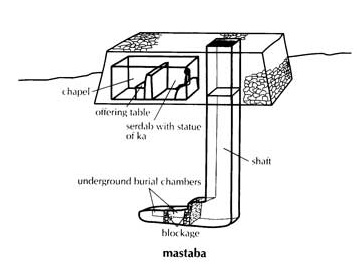
Here is a picture of the Mastabat Fara'un, the tomb of Shepseskaf, last pharaoh of the 4th Dynasty. It's located in Saqqara.
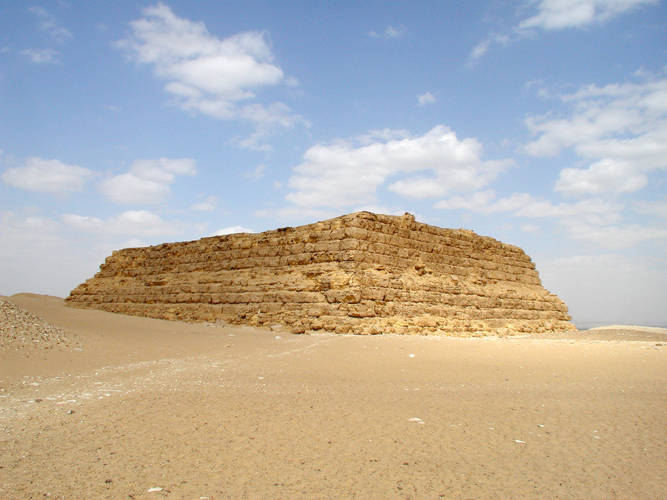
Here's a picture of the stepped superstructure of Mastaba 3038 from the reign of Anedjib/Adjib which is located in Saqqara. It was built in three phases and is believed to have inspired the Pyramid of Djoser (image source):
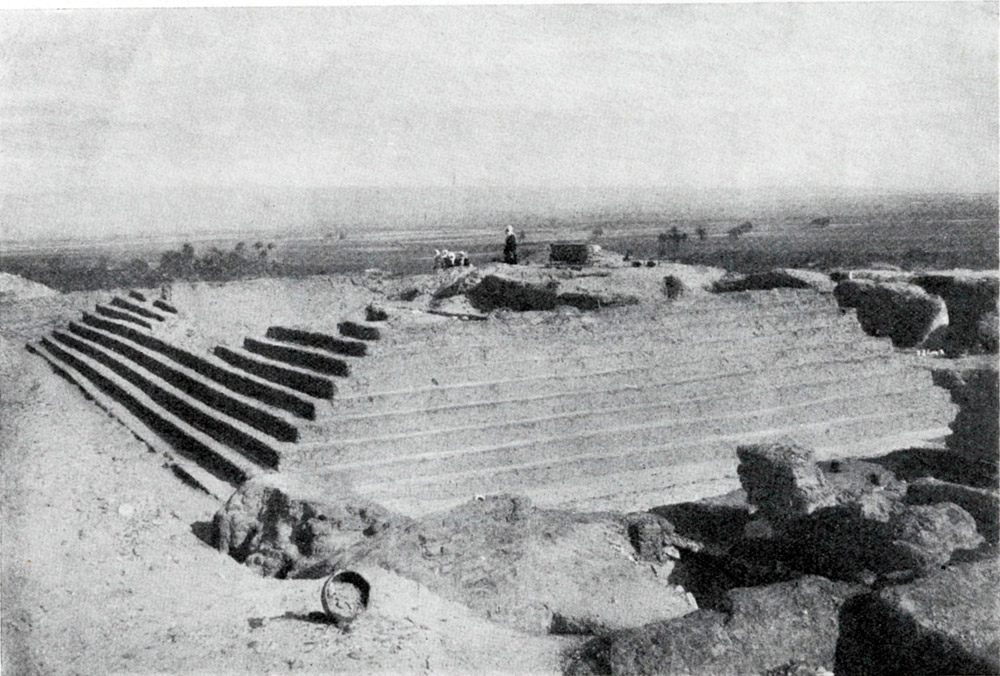
Pyramid of Djoser
This is the oldest known stone cut pyramid in Egypt, the Pyramid of Djoser (image source):
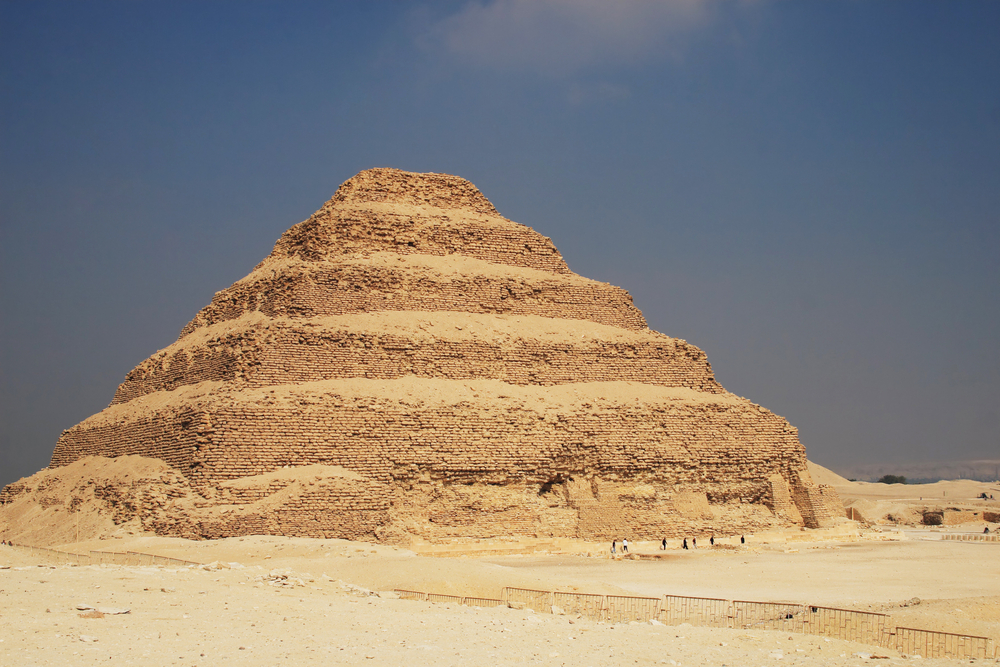
From Wikipedia:
Here's a diagram of the Pyramid of Djoser showing the initial mastaba and noting phases of construction (image source):
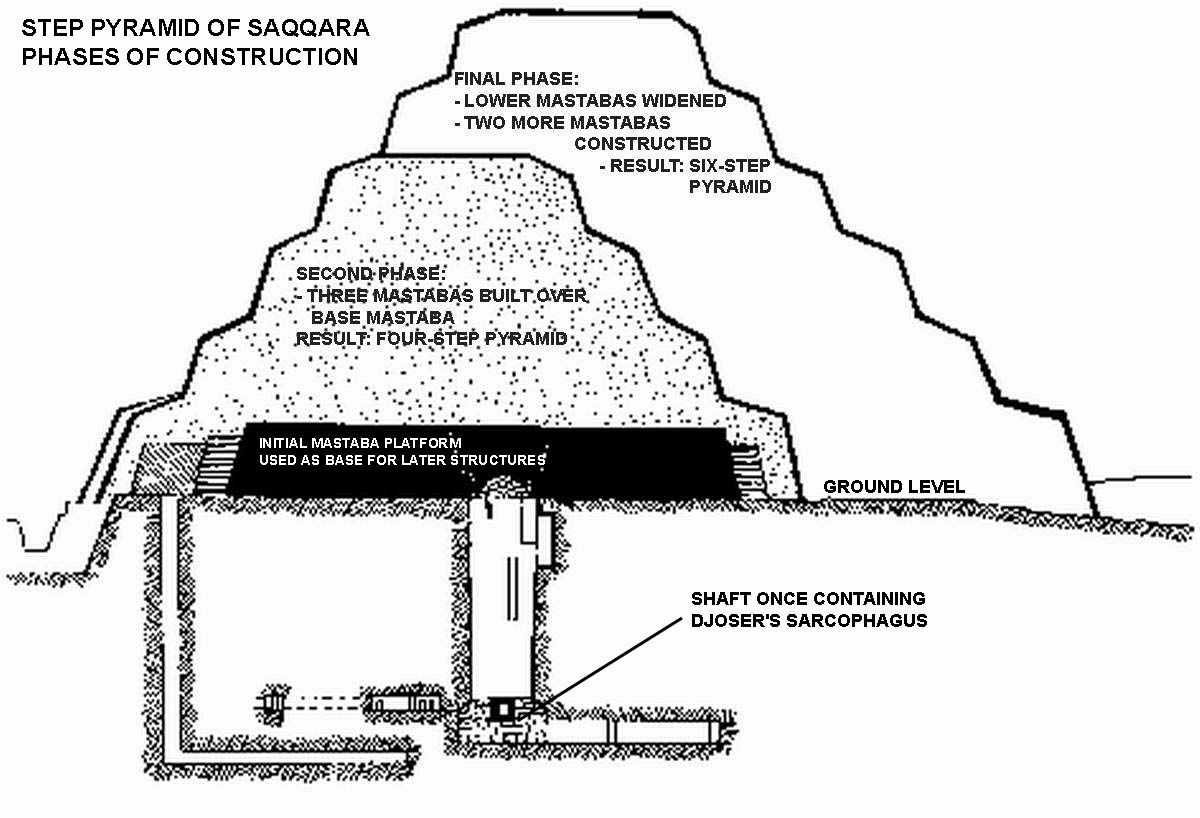
Mastabas
From Wikipedia:
The mastaba was the standard type of tomb in pre-dynastic and early dynastic Egypt for both the pharaoh and the social elite. The ancient Egyptian city of Abydos was the location chosen for many of the cenotaphs. The royal cemetery was at Saqqara, overlooking the capital of early times, Memphis.
Mastabas evolved over early dynastic period. During the 1st Dynasty, a mastaba was constructed simulating house plans of several rooms, a central one containing the sarcophagus and others surrounding it to receive the abundant funerary offerings. The whole was built in a shallow pit above which a brick superstructure covered a broad area. The typical of 2nd and 3rd Dynasty mastabas was the 'stairway mastaba', the tomb chamber of which sank deeper than before and was connected to the top with inclined shaft and stairs.
Even after pharaohs began to construct pyramids for their tombs in the 3rd Dynasty, members of the nobility continued to be buried in mastaba tombs. This is especially evident on the Giza Plateau, where hundreds of mastaba tombs have been constructed alongside the pyramids.
In the 4th Dynasty (ca. 2613 to 2494 BC), rock-cut tombs began to appear. These were tombs built into the rock cliffs in Upper Egypt in an attempt to further thwart grave robbers. Mastabas, then, were developed with the addition of offering chapel and vertical shaft. 5th Dynasty mastabas had elaborate chapels consisting of several rooms, columned hall and 'serdab'. The actual tomb chamber was built below the south-end of mastaba, connected with a slanting passage to a stairway emerging in the center of columned hall or court.
By the time of the New Kingdom (which began with the 18th Dynasty around 1550 BC), "the mastaba becomes rare, being largely superseded by the independent pyramid chapel above a burial chamber."
Diagram showing a typical mastaba design (image source):

Here is a picture of the Mastabat Fara'un, the tomb of Shepseskaf, last pharaoh of the 4th Dynasty. It's located in Saqqara.

Here's a picture of the stepped superstructure of Mastaba 3038 from the reign of Anedjib/Adjib which is located in Saqqara. It was built in three phases and is believed to have inspired the Pyramid of Djoser (image source):

Pyramid of Djoser
This is the oldest known stone cut pyramid in Egypt, the Pyramid of Djoser (image source):

From Wikipedia:
The Pyramid of Djoser (or Zoser), or step pyramid (kbhw-ntrw in Egyptian) is an archeological remain in the Saqqara necropolis, Egypt, northwest of the city of Memphis. It was built during the 27th century BC for the burial of Pharaoh Djoser by Imhotep, his vizier. It is the central feature of a vast mortuary complex in an enormous courtyard surrounded by ceremonial structures and decoration.
This first Egyptian pyramid consisted of six mastabas (of decreasing size) built atop one another in what were clearly revisions and developments of the original plan. The pyramid originally stood 62 metres (203 ft) tall, with a base of 109 m × 125 m (358 ft × 410 ft) and was clad in polished white limestone.[2] The step pyramid (or proto-pyramid) is considered to be the earliest large-scale cut stone construction,[3] although the nearby enclosure known as Gisr el-mudir would seem to predate the complex.
Here's a diagram of the Pyramid of Djoser showing the initial mastaba and noting phases of construction (image source):

edit on 2015-11-6 by theantediluvian because: (no reason given)
Pyramid at Meidum
Next in the evolution of the pyramid is the pyramid at Meidum (image source):
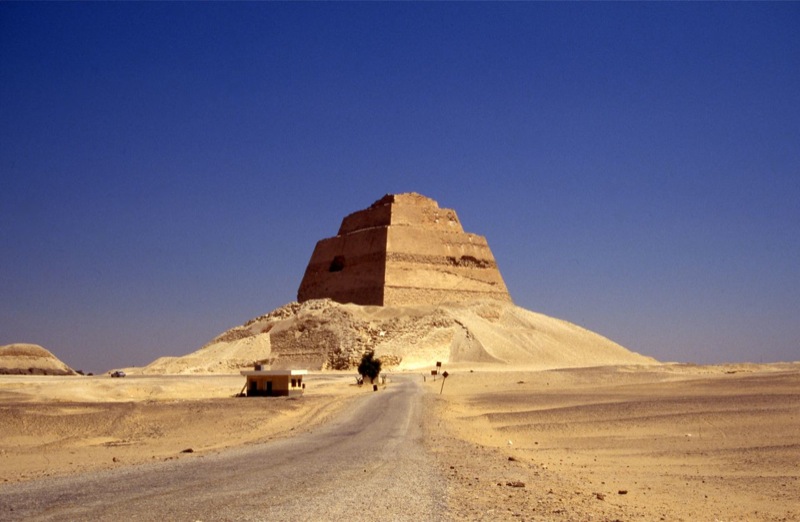
Wikipedia:
The Bent Pyramid
Sneferu's second pyramid (image source):

From Wikipedia:
The Red Pyramid
Finally we arrive at Sneferu's third pyramid, the Red Pyramid (image source):
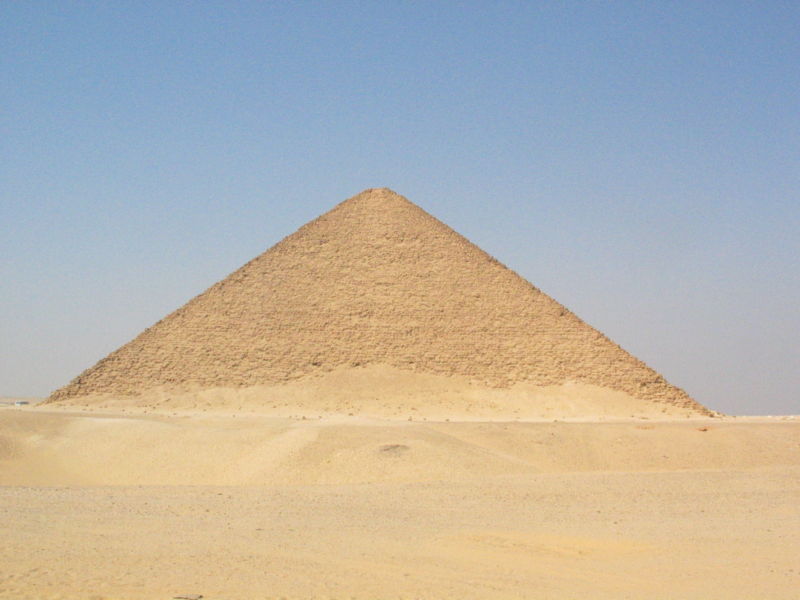
Located about a kilometer from the Bent Pyramid, it's the third largest pyramid in Egypt. The reigns of Djoser and the handful of pharaohs through to Sneferu was only a bit over a century. During this time, the evolution of pyramid construction is CLEARLY visible.
The next pharaoh? Khufu who is believed to be the pharaoh for which the Great Pyramid (aka The Pyramid of Khufu) was built.
Next in the evolution of the pyramid is the pyramid at Meidum (image source):

Wikipedia:
The pyramid at Meidum is thought to originally have been built for Huni, the last pharaoh of the Third Dynasty, and was continued by Sneferu. The architect was a successor to the famous Imhotep, the inventor of the stone built pyramid. The collapse of the pyramid is likely due to the modifications made to Imhotep's pyramid design as well as the decisions taken twice during construction to extend the pyramid. Because of its unusual appearance, the pyramid is called el-heram el-kaddaab — (Pseudo Pyramid) in Egyptian Arabic.
The second extension turned the original step pyramid design into a true pyramid by filling in the steps with limestone encasing. While this approach is consistent with the design of the other true pyramids, Meidum was affected by construction errors. Firstly, the outer layer was founded on sand and not on rock, like the inner layers. Secondly, the inner step pyramids had been designed as the final stage. Thus the outer surface was polished and the platforms of the steps were not horizontal, but fell off to the outside. This severely compromised the stability and is likely to have caused the collapse of the Meidum Pyramid in a downpour while the building was still under construction.[1]
The Bent Pyramid
Sneferu's second pyramid (image source):

From Wikipedia:
The Bent Pyramid is an ancient Egyptian pyramid located at the royal necropolis of Dahshur, approximately 40 kilometres south of Cairo, built under the Old Kingdom Pharaoh Sneferu (c. 2600 BC). A unique example of early pyramid development in Egypt, this was the second pyramid built by Sneferu.
The Bent Pyramid rises from the desert at a 54-degree inclination, but the top section is built at the shallower angle of 43 degrees, lending the pyramid its very obvious 'bent' appearance.[1]
Archaeologists now believe that the Bent Pyramid represents a transitional form between step-sided and smooth-sided pyramids (see Step pyramid). It has been suggested that due to the steepness of the original angle of inclination the structure may have begun to show signs of instability during construction, forcing the builders to adopt a shallower angle to avert the structure's collapse.[2] This theory appears to be borne out by the fact that the adjacent Red Pyramid, built immediately afterwards by the same Pharaoh, was constructed at an angle of 43 degrees from its base
The Red Pyramid
Finally we arrive at Sneferu's third pyramid, the Red Pyramid (image source):

Located about a kilometer from the Bent Pyramid, it's the third largest pyramid in Egypt. The reigns of Djoser and the handful of pharaohs through to Sneferu was only a bit over a century. During this time, the evolution of pyramid construction is CLEARLY visible.
The next pharaoh? Khufu who is believed to be the pharaoh for which the Great Pyramid (aka The Pyramid of Khufu) was built.
edit on 2015-11-6
by theantediluvian because: (no reason given)
a reply to: theantediluvian
You mean to tell me they were just tombs?
But...But.. Ancient aliens on the history channel told me they were built as star gates!!
You mean to tell me they were just tombs?
But...But.. Ancient aliens on the history channel told me they were built as star gates!!
a reply to: theantediluvian
Nah. I mean, naaaaaaah. Just naaaaaaaaaaah.
Aliens did it! You can see it was aliens coz of the shape.
Do you really think stargate was fiction? It was obviously more of a history lesson!!
/ sarcasm
On a serious note, about time someone posted this.
Nah. I mean, naaaaaaah. Just naaaaaaaaaaah.
Aliens did it! You can see it was aliens coz of the shape.
Do you really think stargate was fiction? It was obviously more of a history lesson!!
/ sarcasm
On a serious note, about time someone posted this.
I think the main argument is missed in the OP without the need to sinking down to the Ancient Aliens level.
It is entirely possible that the "Great" Pyramid were built in the "1st times", only to receive renovations during the time it was supposed to have been built. That of course is neither here nore there as the discussion of the OP is geared towards the "why" as evidenced in the OP, I.e. Sarcophagi.
Seeing how I'm not an Egyptologist, I'll just say from a layman perspective, I can see how the Egyptians would have marveled ad such a grand site and spent several generations learning to emulate the construction of them as a place to honor and revere their pharoahs.
To simply say "I think it was Ancient Aliens" responsible for the confusion is highly disingenuous and will on marginalize those with an alternate view. You've neutered the OP before it started. There are several researchers who think along the same lines I noted above without the need to sink down to aliens or ad hominem because someone thinks outside the accreted view of mainstream archeologists, because no doubt that's all this thread will devolve to anyway.
In fact, it's nearly impossible to have a grown discussion about this topic on ATS, the same old figures from both sides always insure to stop the discussion by walking in and #ing on the carpet.
On a side note, my physics professor thinks they were built by Martians a long time ago. Don't figure. but he also says he can predict the stock market using fib sequence, which I follow. Stocks are based on human emotion which collective does make it predictable by and large. Oops, sorry, off topic.
It is entirely possible that the "Great" Pyramid were built in the "1st times", only to receive renovations during the time it was supposed to have been built. That of course is neither here nore there as the discussion of the OP is geared towards the "why" as evidenced in the OP, I.e. Sarcophagi.
Seeing how I'm not an Egyptologist, I'll just say from a layman perspective, I can see how the Egyptians would have marveled ad such a grand site and spent several generations learning to emulate the construction of them as a place to honor and revere their pharoahs.
To simply say "I think it was Ancient Aliens" responsible for the confusion is highly disingenuous and will on marginalize those with an alternate view. You've neutered the OP before it started. There are several researchers who think along the same lines I noted above without the need to sink down to aliens or ad hominem because someone thinks outside the accreted view of mainstream archeologists, because no doubt that's all this thread will devolve to anyway.
In fact, it's nearly impossible to have a grown discussion about this topic on ATS, the same old figures from both sides always insure to stop the discussion by walking in and #ing on the carpet.
On a side note, my physics professor thinks they were built by Martians a long time ago. Don't figure. but he also says he can predict the stock market using fib sequence, which I follow. Stocks are based on human emotion which collective does make it predictable by and large. Oops, sorry, off topic.
edit on 6-11-2015 by Rosinitiate because: (no reason given)
edit on 6-11-2015 by Rosinitiate because: (no reason
given)
Nope. Ben Carson *REALLY* knows what the pyramids were for...
Ben Carson Says Pyramids were built to store grain
Wow, thanks for clearing that up, Ben.
Ben Carson Says Pyramids were built to store grain
Wow, thanks for clearing that up, Ben.
a reply to: theantediluvian
Nobody does 'know' - we can only draw conclusions based on what we find and examine.
The same applies to everything from 100's/1000's of years ago.
Nobody does 'know' - we can only draw conclusions based on what we find and examine.
The same applies to everything from 100's/1000's of years ago.
originally posted by: Leonidas
Nope. Ben Carson *REALLY* knows what the pyramids were for...
Ben Carson Says Pyramids were built to store grain
Wow, thanks for clearing that up, Ben.
That's "lore" from the Medieval Period link. Creationists very often fall back on that belief asserted back when people knew nothing about the subject.
Carson's faith erroneously leads him to that belief.
On the other hand, that excuse doesn't work for Scott Creighton.
Harte
a reply to: theantediluvian
May i ask where does the great pyramid of Giza stand in this theory was it also a tomb ?
May i ask where does the great pyramid of Giza stand in this theory was it also a tomb ?
a reply to: Rosinitiate
ATS isn't a site to have any grown discussion when opinions are expressed that fall outside of the mainstream science.
just cut and past wiki about pyramids that is how it works
In fact, it's nearly impossible to have a grown discussion about this topic on ATS,
ATS isn't a site to have any grown discussion when opinions are expressed that fall outside of the mainstream science.
just cut and past wiki about pyramids that is how it works
edit on 52015pAmerica/Chicago by raytheo because: (no reason given)
I only have a layman's background as well, but the idea that the great pyramids were from an older civ and emulated by the Egyptians... and that the
shape was used as tombs for Pharaohs because of that association to the original 3 great pyramids (whew), could be valid.
No aliens needed.
Er, or what Rose said... better.
No aliens needed.
Er, or what Rose said... better.
Perhaps there is more to the story..
Ziggurats from Sumerian civilization, may possibly predate the pyramids of Egypt.
Eridu is one of the older cities.
 Ruins at Eridu
Ruins at Eridu
Ziggurats were usually part of a temple complex. Shrines and temples usually inhabited the upper-most tier.
----
----
Haha.. ancient aliens again.
So according to Mesopotamian lore, Eridu was one of the first dwelling places of the first kings that lived thousands of years. And ziggurats were the dwelling places of these 'Gods'. And even one particular ziggurat was called "House of the Platform between Heaven and Earth". Unlike the Egyptian pyramids, ziggurats usually had a flat platform on top.
So, it may be possible that the Egyptian pyramids copied, or got the idea of their structures from the ziggurats to use as tombs for their kings.
People like Sitchin speculate that while ziggurats were originally used as landing platforms for the ET's/ extra-dimensional Gods, that after they left the Earth (or no longer visited) eventually became used instead for rituals and sacrifices.
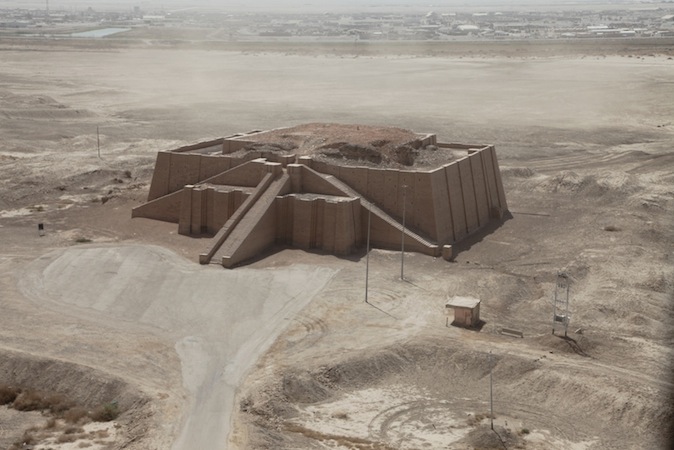 ziggurat of Ur
ziggurat of Ur
 ziggurat of Ur
ziggurat of Ur
 ziggurat like structure in Mexico
ziggurat like structure in Mexico
Ziggurats from Sumerian civilization, may possibly predate the pyramids of Egypt.
Eridu is one of the older cities.

Ziggurats were usually part of a temple complex. Shrines and temples usually inhabited the upper-most tier.
"Each ziggurat was part of a temple complex that included a courtyard, storage rooms, bathrooms, and living quarters, around which a city was built."
"The Mesopotamians believed that these pyramid temples connected heaven and earth. In fact, the ziggurat at Babylon was known as Etemenankia or "House of the Platform between Heaven and Earth"."
- en.wikipedia.org...
The Mesopotamian ziggurats were not places for public worship or ceremonies. They were believed to be dwelling places for the gods and each city had its own patron god. Only priests were permitted on the ziggurat or in the rooms at its base.. The priests were very powerful members of Sumerian society.
----
In Sumerian mythology, Eridu was the home of the Abzu temple of the god Enki
- en.wikipedia.org...
According to the Sumerian kinglist Eridu was the first city in the World. The opening line reads, "When kingship from heaven was lowered, the kingship was in Eridu."
----
Haha.. ancient aliens again.
So according to Mesopotamian lore, Eridu was one of the first dwelling places of the first kings that lived thousands of years. And ziggurats were the dwelling places of these 'Gods'. And even one particular ziggurat was called "House of the Platform between Heaven and Earth". Unlike the Egyptian pyramids, ziggurats usually had a flat platform on top.
So, it may be possible that the Egyptian pyramids copied, or got the idea of their structures from the ziggurats to use as tombs for their kings.
People like Sitchin speculate that while ziggurats were originally used as landing platforms for the ET's/ extra-dimensional Gods, that after they left the Earth (or no longer visited) eventually became used instead for rituals and sacrifices.



Interesting but what about the granite coffer
The granite coffer in the “King’s Chamber” is too big to fit through the passages and so it must have been put in place during construction.
The coffer was made out of a block of solid granite. This would have required bronze saws 8-9 ft. long set with teeth of sapphires. Hollowing out of the interior would require tubular drills of the same material applied with a tremendous vertical force.
Microscopic analysis of the coffer reveals that it was made with a fixed point drill that used hard jewel bits and a drilling force of 2 tons.
Aliens probably not but an earlier civilisation maybe
The granite coffer in the “King’s Chamber” is too big to fit through the passages and so it must have been put in place during construction.
The coffer was made out of a block of solid granite. This would have required bronze saws 8-9 ft. long set with teeth of sapphires. Hollowing out of the interior would require tubular drills of the same material applied with a tremendous vertical force.
Microscopic analysis of the coffer reveals that it was made with a fixed point drill that used hard jewel bits and a drilling force of 2 tons.
Aliens probably not but an earlier civilisation maybe
Diluvian, can I hypothesize that the responses here aren't encouraging you?
I keep talking about the dangers of "belief-based" understandings of reality, and we're seeing the beginnings of an ultimate culmination of that.
It doesn't matter what a century (or more) of Egyptologists have demonstrated clearly. They are all leftist liberal elitists.
It doesn't matter what the Egyptians actually told us ... because hey, that's not in the Bible, now is it?
Pyramids could be alien landing platforms ... you "weren't there dude how do you know? My opinion is as good as yours."
/sigh
I keep talking about the dangers of "belief-based" understandings of reality, and we're seeing the beginnings of an ultimate culmination of that.
It doesn't matter what a century (or more) of Egyptologists have demonstrated clearly. They are all leftist liberal elitists.
It doesn't matter what the Egyptians actually told us ... because hey, that's not in the Bible, now is it?
Pyramids could be alien landing platforms ... you "weren't there dude how do you know? My opinion is as good as yours."
/sigh
i am just translating a book by Hungarian architect András Gőczey on the astronomical measurements hidden in the great Giza complex. It will be
published in Australia next year.
It looks like the function of an astronomical calendar was truly built into those (the pyramids of Khufu, Khafre and Menkaure from the 4th dynasty of the Old Kingdom). Specifically, the sunrise of the day of the summer and winter solstices, as well as those of the spring and fall equinox were shown by the shadow of the apex of the subsidiary minor pyramids was designed to fall exactly on the edge of the Khafre pyramid, while the phases of the Moon at its lowest observable point were also observed, plus the angle of the largest pyramids was designed to show the mean distance of the Moon as observable from Egypt...
Look at this short video prepared by Mr. Gőczey and an animator:
Menkaure's Hidden Calendar
Thank you for a an informative presentation of the earlier pyramids and their evolution over the centuries.
It looks like the function of an astronomical calendar was truly built into those (the pyramids of Khufu, Khafre and Menkaure from the 4th dynasty of the Old Kingdom). Specifically, the sunrise of the day of the summer and winter solstices, as well as those of the spring and fall equinox were shown by the shadow of the apex of the subsidiary minor pyramids was designed to fall exactly on the edge of the Khafre pyramid, while the phases of the Moon at its lowest observable point were also observed, plus the angle of the largest pyramids was designed to show the mean distance of the Moon as observable from Egypt...
Look at this short video prepared by Mr. Gőczey and an animator:
Menkaure's Hidden Calendar
Thank you for a an informative presentation of the earlier pyramids and their evolution over the centuries.
However and whoever made all the pyramids thanks for the total mind screw to later civilizations.
As I see them it is a gateway or step to the next dimension or higher level after death, kings feeling they deserved a place with the gods in the heavens this was their way of attempting this I believe. Also some interesting theories that we at one time had the abilities and commingled with the gods and where able to travel in between dimensions and some where along the line we lost that ability maybe after Atlantis and the pyramids where made to replicate that in a way.
Who knows all in all we have gone along way over the years how did people manage to do these things so long ago I dunno make a list when you die maybe you can have all you're questions answered!
As I see them it is a gateway or step to the next dimension or higher level after death, kings feeling they deserved a place with the gods in the heavens this was their way of attempting this I believe. Also some interesting theories that we at one time had the abilities and commingled with the gods and where able to travel in between dimensions and some where along the line we lost that ability maybe after Atlantis and the pyramids where made to replicate that in a way.
Who knows all in all we have gone along way over the years how did people manage to do these things so long ago I dunno make a list when you die maybe you can have all you're questions answered!
originally posted by: Rosinitiate
It is entirely possible that the "Great" Pyramid were built in the "1st times", only to receive renovations during the time it was supposed to have been built. That of course is neither here nore there as the discussion of the OP is geared towards the "why" as evidenced in the OP, I.e. Sarcophagi.
Actually, it IS covered.
You don't get technology like huge stone buildings in a vacuum. Homo eregaster doesn't suddenly fall out of a tree and say "gosh, that hurts! I'm building a hotel out of rocks instead!"
In order to have the GP, you also have to have:
* rock quarries
* tools for quarrying
* a trained workforce for quarrying
* experienced stonemasons to get the blocks to fit together
* transportation systems and labor force for large amounts of large rocks
* food and housing for these people
* overseers/coordinators in addition to a main architect/boss
* ropes and levers and other technology for construction
* experienced construction workers (not everyone, but enough to teach the raw recruits.
* roads
Each of those things leaves marks on the landscape that we can find with our current technology (lots of recent stories about archaeologists who have identified and then confirmed sites that were only visible from satellite photographs.) They also leave marks on the stones (tool marks) and in spite of the gosh-wow "perfect interior", etc (I've been in the Great Pyramid and the Bent Pyramid) the walls are not high-tech smoothed and you CAN see marks from pounding in the rocks.
So in order for it to be an "earlier civilization" there has to be traces of a large number of earlier people living in the area with stonework capability and they would leave indications (charcoal, graves, kitchens, fire pits, etc, etc) that they were there.
You then have to explain how more than a hundred thousand people forgot their technology and didn't export it. The "giant planetary stupidity field" doesn't work -- during the Dark Ages what was lost was communication and transportation and government coordination (people still knew how to build and construct as their parents did.)
Seeing how I'm not an Egyptologist, I'll just say from a layman perspective, I can see how the Egyptians would have marveled ad such a grand site and spent several generations learning to emulate the construction of them as a place to honor and revere their pharoahs.
While they DID reuse monuments and statues by other pharaohs (Rameses II was particularly bad about this, but a lot of the others did it as well), it's pretty obvious when they do and they don't need the huge workforce that was present at Giza. If they'd reworked it from an older site, we'd see graves and indications that were far older than Khufu's time and were of a different culture (different types of pottery and decoration and food choices) and only a relative few from the 4th and 5th dynasties.
originally posted by: redchad
Interesting but what about the granite coffer
The granite coffer in the “King’s Chamber” is too big to fit through the passages and so it must have been put in place during construction.
The coffer was made out of a block of solid granite. This would have required bronze saws 8-9 ft. long set with teeth of sapphires. Hollowing out of the interior would require tubular drills of the same material applied with a tremendous vertical force.
Actually, it doesn't require tubular drills or anything of the sort. If you go to Luxor (I've been there) and look at the Unfinished Obelisk you can see that they were able to work granite with pounding stones (there's still a lot of these rock "hammers" in the quarry.) Petrie himself demonstrated how the interior could be done with a simple weighted drill bow.
a reply to: Gryphon66
I think what you're missing in your snarky post is that there is plenty of precedent to show that the length of time that an idea is believed does not equate it to being factual.
Furthermore, it's possible (and some would say probable) that the archeological belief system that guides the generally accepted view of the history of the pyramids has evolved in its current direction because it may have started off on the wrong path. It's very hard to restart an accepted view of history once it has a foothold--hell, the celebration of Columbus Day in the U.S. is a perfect example, as we now widely know that (a) he wasn't the first European to "discover" America, and (b) that he was pretty much a complete jackass unworthy of reverence at a national level. But, yet, here we are, still teaching how awesome he was to school children and giving them the day off.
I know, that's not the best example--maybe the length of time that it took for world-wide acceptance of a heliocentric model of the universe governed (in part) by gravity is a better example, but you get my point. Just because a 'scientific' view is held for a long time does not mean that it is infallible or even correct.
It is in this spirit that many who are skeptical of the mainstream point of view on the history of the world--Egypt and its Giza Plateau included--derive their skepticism. It's healthy for science, as long as there is at least some tangible evidence to back up the hypothesis.
We all know that history is generally a one-sided telling of a story, and we all know that this doesn't always make the story factual.
I think what you're missing in your snarky post is that there is plenty of precedent to show that the length of time that an idea is believed does not equate it to being factual.
Furthermore, it's possible (and some would say probable) that the archeological belief system that guides the generally accepted view of the history of the pyramids has evolved in its current direction because it may have started off on the wrong path. It's very hard to restart an accepted view of history once it has a foothold--hell, the celebration of Columbus Day in the U.S. is a perfect example, as we now widely know that (a) he wasn't the first European to "discover" America, and (b) that he was pretty much a complete jackass unworthy of reverence at a national level. But, yet, here we are, still teaching how awesome he was to school children and giving them the day off.
I know, that's not the best example--maybe the length of time that it took for world-wide acceptance of a heliocentric model of the universe governed (in part) by gravity is a better example, but you get my point. Just because a 'scientific' view is held for a long time does not mean that it is infallible or even correct.
It is in this spirit that many who are skeptical of the mainstream point of view on the history of the world--Egypt and its Giza Plateau included--derive their skepticism. It's healthy for science, as long as there is at least some tangible evidence to back up the hypothesis.
We all know that history is generally a one-sided telling of a story, and we all know that this doesn't always make the story factual.
edit on 6-11-2015 by SlapMonkey because: (no reason given)
new topics
-
“They’re Gonna Pay for It:” Could a Texas Billionaire Force Greenpeace USA into Bankruptcy?
Breaking Alternative News: 34 minutes ago -
RIP James Earl Jones 93
People: 2 hours ago -
Kamala Harris Campaign Site Lists Policy Page Seven Weeks After Entering Race
2024 Elections: 3 hours ago -
Ruth and 1 Samuel
Religion, Faith, And Theology: 4 hours ago -
Opinion Beijing set out to destroy U.S. economic supremacy. It’s nearing its target.
Other Current Events: 6 hours ago -
Farmers Almanac Winter 2024/2025 "Calmer Gentler Winter"
General Chit Chat: 8 hours ago -
Japanese Researchers Link Covid Shots to 201 Dangerous Diseases
Science & Technology: 8 hours ago -
This person could be our next president.
Politicians & People: 9 hours ago -
Would you like fries with that?
US Political Madness: 11 hours ago
top topics
-
Would you like fries with that?
US Political Madness: 11 hours ago, 22 flags -
Japanese Researchers Link Covid Shots to 201 Dangerous Diseases
Science & Technology: 8 hours ago, 15 flags -
This person could be our next president.
Politicians & People: 9 hours ago, 12 flags -
RIP James Earl Jones 93
People: 2 hours ago, 12 flags -
Farmers Almanac Winter 2024/2025 "Calmer Gentler Winter"
General Chit Chat: 8 hours ago, 7 flags -
Kamala Harris Campaign Site Lists Policy Page Seven Weeks After Entering Race
2024 Elections: 3 hours ago, 7 flags -
Opinion Beijing set out to destroy U.S. economic supremacy. It’s nearing its target.
Other Current Events: 6 hours ago, 6 flags -
Facebook slowing down access to political posts
Education and Media: 14 hours ago, 5 flags -
Ruth and 1 Samuel
Religion, Faith, And Theology: 4 hours ago, 2 flags -
“They’re Gonna Pay for It:” Could a Texas Billionaire Force Greenpeace USA into Bankruptcy?
Breaking Alternative News: 34 minutes ago, 2 flags
active topics
-
Florida makes it illegal to pick saw palmetto berries
US Political Madness • 26 • : marg6043 -
Altiyan Childs Exposes Freemasonry
New World Order • 7 • : BeyondKnowledge3 -
Would you like fries with that?
US Political Madness • 35 • : Degradation33 -
Governor Kathy Hochul violates the Posse Comitatus Act
Posse Comitatus • 20 • : xuenchen -
This person could be our next president.
Politicians & People • 58 • : chr0naut -
President Donald Trump 2.0 - From 2025 thru 2029 - General Musings - Assumptions - Requirements.
2024 Elections • 69 • : WeMustCare -
Donald TRUMP on the Fate of Election Fraudsters if Americans Elect Him President Again.
2024 Elections • 83 • : network dude -
“They’re Gonna Pay for It:” Could a Texas Billionaire Force Greenpeace USA into Bankruptcy?
Breaking Alternative News • 0 • : fringeofthefringe -
Nano bots in the vaccine
Science & Technology • 102 • : 5thHead -
KAMALA HARRIS is Having a Hard Time Readying for the 9-10-2024 Debate with Donald Trump.
2024 Elections • 111 • : DBCowboy
